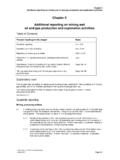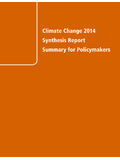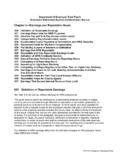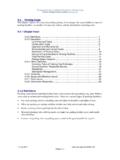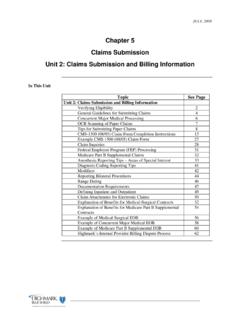Transcription of CHAPTER 5. DETERMINING INCOME AND CALCULATING …
1 HUD Occupancy Handbook 5-1 6/07 CHAPTER 5: DETERMINING INCOME & CALCULATING Rent REV-1 CHAPTER 5. DETERMINING INCOME AND CALCULATING RENT 5-1 Introduction A. Owners must determine the amount of a family s INCOME before the family is allowed to move into assisted housing and at least annually thereafter. The amount of assistance paid on behalf of the family is calculated using the family s annual INCOME less allowable deductions. HUD program regulations specify the types and amounts of INCOME and deductions to be included in the calculation of annual and adjusted INCOME . B. Although the definitions of annual and adjusted INCOME used for the programs covered in this handbook have some similarities with rules used by the Internal Revenue Service (IRS), the tax rules are different from the HUD program rules. C. The most frequent errors encountered in reviews of annual and adjusted INCOME determinations in tenant files fall in three categories: 1.
2 Applicants and tenants failing to fully disclose INCOME information; 2. Errors in identifying required INCOME exclusions; and 3. Incorrect calculations of deductions, often the result of failure to obtain third-party verification. Careful interviewing and thorough verification can minimize the occurrence of these errors. D. CHAPTER 5 is organized as follows: Section 1: DETERMINING Annual INCOME discusses the requirements regarding annual INCOME and the procedure for CALCULATING a family s annual INCOME when DETERMINING eligibility. This section also includes guidance on DETERMINING INCOME from assets. Section 2: DETERMINING Adjusted INCOME describes the procedures and requirements for DETERMINING adjusted INCOME based on allowable deductions. Section 3: Verification presents the requirements for verifying information provided by applicants and tenants related to their eligibility.
3 Section 4: CALCULATING Tenant Rent discusses the methods for CALCULATING the tenant s portion of rent under the different programs covered by this handbook. HUD Occupancy Handbook 5-2 8/13 CHAPTER 5: DETERMINING INCOME & CALCULATING Rent REV-1 5-2 Key Terms A. There are a number of technical terms used in this CHAPTER that have very specific definitions established by federal statute or regulations, or by HUD. These terms are listed in Figure 5-1 and their definitions can be found in the Glossary to this handbook. It is important to be familiar with these definitions when reading this CHAPTER . B. The terms disability and persons with disabilities are used in two contexts for civil rights protections, and for program eligibility purposes. Each use has specific definitions. 1. When used in context of protection from discrimination or improving the accessibility of housing, the civil rights-related definitions apply.
4 2. When used in the context of eligibility under multifamily subsidized housing programs, the program eligibility definitions apply. NOTE: See the Glossary for specific definitions and paragraph 2-23 for an explanation of this difference. Figure 5-1: Key Terms Adjusted INCOME Annual INCOME Assets Assistance payment Assisted rent Assisted tenant Basic rent Co-head of household Contract rent Dependent *Enterprise INCOME Verification (EIV)* Extremely low- INCOME family Foster adult Foster children Full-time student Gross rent Hardship exemption Head of household Housing assistance payment (HAP) INCOME limit Live-in aide Low- INCOME family Market rent Minimum rent Operating rent Project Assistance Contract (PAC) PRAC Operating Rent Project Rental Assistance Contract (PRAC) Project assistance payment Project rental assistance payment Tenant rent Total tenant payment Unearned INCOME Utility allowance Utility reimbursement Very low- INCOME family Welfare assistance Welfare rent Section 1.
5 DETERMINING Annual INCOME HUD Occupancy Handbook 5-3 6/07 CHAPTER 5: DETERMINING INCOME & CALCULATING Rent REV-1 Section 1: DETERMINING Annual INCOME 5-3 Key Regulations This paragraph identifies the key regulatory citation pertaining to Section 1: DETERMINING Annual INCOME . The citation and its title are listed below. *24 CFR Mandated Use of HUD s Enterprise INCOME Verification (EIV) System* 24 CFR Annual INCOME 5-4 Key Requirements A. Annual INCOME is the amount of INCOME that is used to determine a family s eligibility for assistance. Annual INCOME is defined as follows: 1. All amounts, monetary or not, that go to or are received on behalf of the family head, spouse or co-head (even if the family member is temporarily absent), or any other family member; or 2. All amounts anticipated to be received from a source outside the family during the 12-month period following admission or annual recertification effective date.
6 B. Annual INCOME includes all amounts that are not specifically excluded by regulation. Exhibit 5-1, INCOME Inclusions and Exclusions, provides a list of INCOME inclusions and exclusions published in the regulations and Federal Register notices. C. Annual INCOME includes amounts derived (during the 12-month period) from assets to which any member of the family has access. 5-5 Methods for Projecting and CALCULATING Annual INCOME A. The requirements for DETERMINING whether a family is eligible for assistance, and the amount of rent the family will pay, require the owner to project or estimate the annual INCOME that the family expects to receive. There are several ways to make this projection. The following are acceptable methods for CALCULATING the annual INCOME anticipated for the coming year: 1. Generally the owner must use current circumstances to anticipate INCOME .
7 The owner calculates projected annual INCOME by annualizing current INCOME . INCOME that may not last for a full 12 months ( , unemployment compensation) should be calculated assuming current circumstances will last a full 12 months. If changes occur later in the year, an interim recertification can be conducted to change the family s rent. Section 1: DETERMINING Annual INCOME HUD Occupancy Handbook 5-4 8/13 CHAPTER 5: DETERMINING INCOME & CALCULATING Rent REV-1 2. If information is available on changes expected to occur during the year, use that information to determine the total anticipated INCOME from all known sources during the year. 3. *Using EIV: (a) The owner must not use the quarterly wage INCOME reported on the EIV INCOME Report for CALCULATING the tenant s annual INCOME from employment. The owner must confirm with the tenant that the information in EIV is correct.
8 If the tenant agrees that the employment information reported in EIV is correct, the owner must: (1) Use the INCOME Report as third party verification of the tenant s employment; and (2) Use tenant provided documents for CALCULATING the tenant s annual INCOME , 4-6 current, consecutive check stubs. Example 1: EIV shows that John is working at Jack s Restaurant and John agrees that he is working there. John has brought in his four most current, consecutive check stubs. The owner must use the EIV INCOME Report as third party verification that John is employed at Jack s Restaurant and use the gross pay shown on the check stubs provided by the tenant for DETERMINING John s annual INCOME . John is paid weekly. Check stubs gross pay 1) $120; 2) $145; 3) $125; 4) $130 total gross pay = $520 $520 / 4 = $130 average gross pay per week $130 x 52 weeks = $6,760 gross annual INCOME Example 2: EIV shows Sally works at Beauty World and Sally agrees that she is working there.
9 Sally has brought in a payroll summary report prepared by her employer which shows that Sally works 30 hours per week and earns $ per hour. The owner must use the EIV INCOME Report as third party verification that Sally is employed at Beauty World and use the payroll summary report prepared by Beauty World for DETERMINING Sally s annual INCOME . 30 hours x 52 weeks = 1,560 hours per year $ per hour x 1,560 hours = $19,500 gross annual INCOME Section 1: DETERMINING Annual INCOME HUD Occupancy Handbook 5-5 8/13 CHAPTER 5: DETERMINING INCOME & CALCULATING Rent REV-1 b. The owner must not use the quarterly unemployment compensation benefits reported on the EIV INCOME Report for CALCULATING the tenant s annual INCOME from unemployment. The owner must confirm with the tenant that the unemployment information in EIV is correct.
10 If the tenant agrees that he/she is receiving unemployment compensation benefits as reported in EIV, the owner must: (1) Use the INCOME Report as third party verification that the tenant is receiving unemployment; and (2) Use tenant provided documents for CALCULATING annual INCOME , unemployment monetary benefit notice. c. If the tenant agrees with the social security benefit information on the EIV INCOME Report, the owner must use the EIV INCOME Report as third party verification, receiving social security benefits and also for CALCULATING the tenant s annual INCOME . Example: Peter has brought in the unemployment benefit notice he received showing he is being paid weekly unemployment benefits of $175. The owner will use the EIV INCOME Report as third party verification that Peter is receiving unemployment benefits and the unemployment benefit notice for DETERMINING Peter s annual INCOME .










